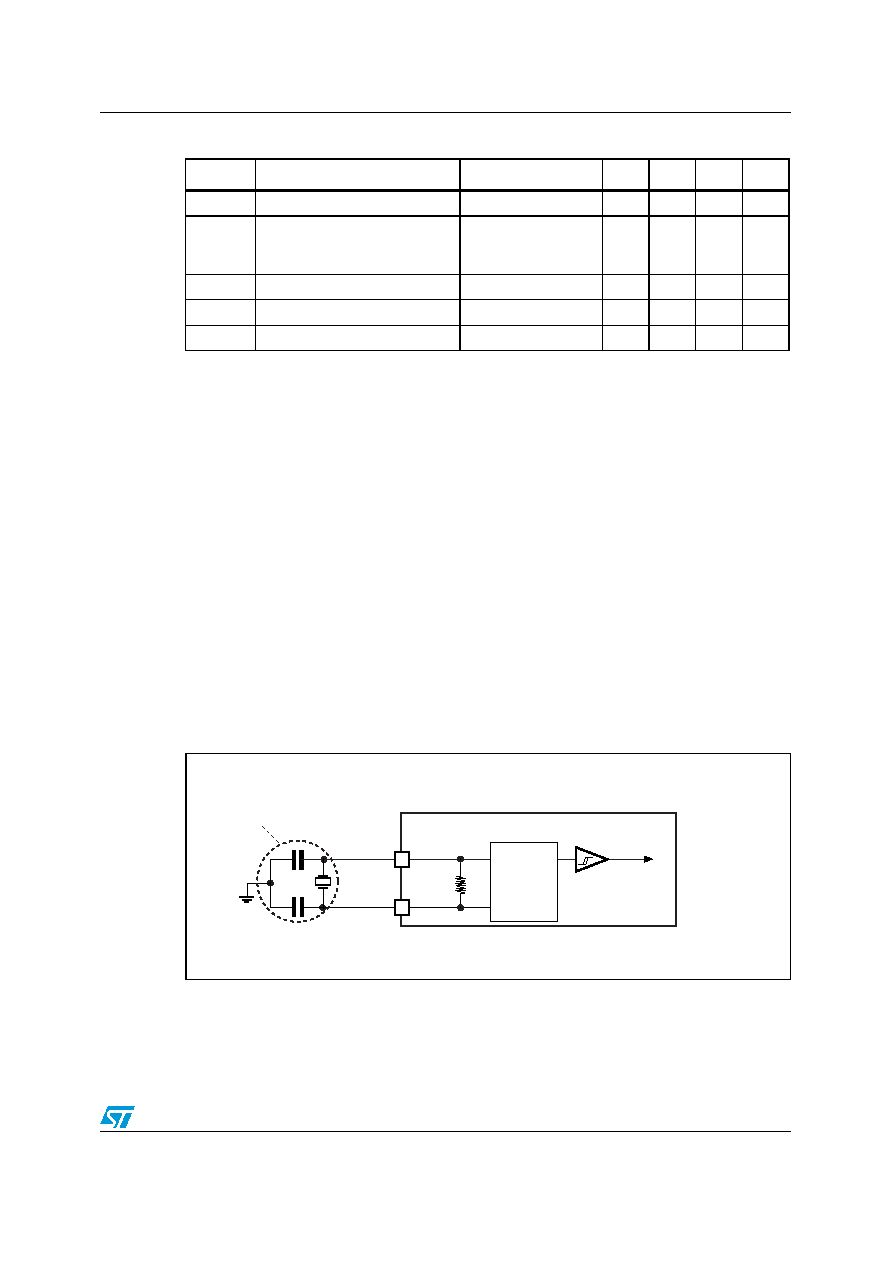- 您现在的位置:买卖IC网 > PDF目录85257 > STM32F103VBT6TR (STMICROELECTRONICS) 32-BIT, FLASH, 1.25 MHz, RISC MICROCONTROLLER, PQFP100 PDF资料下载
参数资料
| 型号: | STM32F103VBT6TR |
| 厂商: | STMICROELECTRONICS |
| 元件分类: | 微控制器/微处理器 |
| 英文描述: | 32-BIT, FLASH, 1.25 MHz, RISC MICROCONTROLLER, PQFP100 |
| 封装: | 14 X 14 MM, ROHS COMPLIANT, LQFP-100 |
| 文件页数: | 47/92页 |
| 文件大小: | 1212K |
| 代理商: | STM32F103VBT6TR |
第1页第2页第3页第4页第5页第6页第7页第8页第9页第10页第11页第12页第13页第14页第15页第16页第17页第18页第19页第20页第21页第22页第23页第24页第25页第26页第27页第28页第29页第30页第31页第32页第33页第34页第35页第36页第37页第38页第39页第40页第41页第42页第43页第44页第45页第46页当前第47页第48页第49页第50页第51页第52页第53页第54页第55页第56页第57页第58页第59页第60页第61页第62页第63页第64页第65页第66页第67页第68页第69页第70页第71页第72页第73页第74页第75页第76页第77页第78页第79页第80页第81页第82页第83页第84页第85页第86页第87页第88页第89页第90页第91页第92页

STM32F103x8, STM32F103xB
Electrical characteristics
Doc ID 13587 Rev 11
Note:
For CL1 and CL2 it is recommended to use high-quality ceramic capacitors in the 5 pF to
15 pF range selected to match the requirements of the crystal or resonator. CL1 and CL2, are
usually the same size. The crystal manufacturer typically specifies a load capacitance which
is the series combination of CL1 and CL2.
Load capacitance CL has the following formula: CL = CL1 x CL2 / (CL1 + CL2) + Cstray where
Cstray is the pin capacitance and board or trace PCB-related capacitance. Typically, it is
between 2 pF and 7 pF.
Caution:
To avoid exceeding the maximum value of CL1 and CL2 (15 pF) it is strongly recommended
to use a resonator with a load capacitance CL 7 pF. Never use a resonator with a load
capacitance of 12.5 pF.
Example: if you choose a resonator with a load capacitance of CL = 6 pF, and Cstray = 2 pF,
then CL1 = CL2 = 8 pF.
Figure 23.
Typical application with a 32.768 kHz crystal
5.3.7
Internal clock source characteristics
The parameters given in Table 24 are derived from tests performed under ambient
Table 23.
LSE oscillator characteristics (fLSE = 32.768 kHz)
(1)
1.
Based on characterization, not tested in production.
Symbol
Parameter
Conditions
Min
Typ
Max
Unit
RF
Feedback resistor
5
M
C(2)
2.
Refer to the note and caution paragraphs below the table, and to the application note AN2867 “Oscillator
design guide for ST microcontrollers.
Recommended load capacitance
versus equivalent serial
resistance of the crystal (RS)
(3)
3.
The oscillator selection can be optimized in terms of supply current using an high quality resonator with
small RS value for example MSIV-TIN32.768kHz. Refer to crystal manufacturer for more details
RS = 30 k
15
pF
I2
LSE driving current
VDD = 3.3 V, VIN = VSS
1.4
A
gm
Oscillator Transconductance
5
A/V
tSU(LSE)
(4)
4.
tSU(LSE) is the startup time measured from the moment it is enabled (by software) to a stabilized 32.768
kHz oscillation is reached. This value is measured for a standard crystal resonator and it can vary
significantly with the crystal manufacturer
startup time
VDD is stabilized
3
s
ai14146
OSC32_OU T
OSC32_IN
fLSE
CL1
RF
STM32F103xx
32.768 kH z
resonator
CL2
Resonator with
integrated capacitors
Bias
controlled
gain
相关PDF资料 |
PDF描述 |
|---|---|
| SC3S12XF512J0CLMR | MICROCONTROLLER, QFP112 |
| SC9S12XF512J0VLH | MICROCONTROLLER, QFP64 |
| SAF-XC2263N-24F66L | 32-BIT, FLASH, 66 MHz, RISC MICROCONTROLLER, PQFP100 |
| SAF-XC2265N-16F66L | 32-BIT, FLASH, 66 MHz, RISC MICROCONTROLLER, PQFP100 |
| SPMCM16Z2BVPV25 | 16-BIT, MROM, 25.17 MHz, MICROCONTROLLER, PQFP144 |
相关代理商/技术参数 |
参数描述 |
|---|---|
| STM32F103VBT6XXX | 制造商:STMICROELECTRONICS 制造商全称:STMicroelectronics 功能描述:Medium-density performance line ARM-based 32-bit MCU with 64 or 128 KB Flash, USB, CAN, 7 timers, 2 ADCs, 9 communication interfaces |
| STM32F103VBT7 | 功能描述:ARM微控制器 - MCU 32BIT Cortex M3 M/D Performance LINE RoHS:否 制造商:STMicroelectronics 核心:ARM Cortex M4F 处理器系列:STM32F373xx 数据总线宽度:32 bit 最大时钟频率:72 MHz 程序存储器大小:256 KB 数据 RAM 大小:32 KB 片上 ADC:Yes 工作电源电压:1.65 V to 3.6 V, 2 V to 3.6 V, 2.2 V to 3.6 V 工作温度范围:- 40 C to + 85 C 封装 / 箱体:LQFP-48 安装风格:SMD/SMT |
| STM32F103VBT7TR | 功能描述:ARM微控制器 - MCU 32-Bit ARM Cortex MED Density 128kb PL RoHS:否 制造商:STMicroelectronics 核心:ARM Cortex M4F 处理器系列:STM32F373xx 数据总线宽度:32 bit 最大时钟频率:72 MHz 程序存储器大小:256 KB 数据 RAM 大小:32 KB 片上 ADC:Yes 工作电源电压:1.65 V to 3.6 V, 2 V to 3.6 V, 2.2 V to 3.6 V 工作温度范围:- 40 C to + 85 C 封装 / 箱体:LQFP-48 安装风格:SMD/SMT |
| STM32F103VBT7XXX | 制造商:STMICROELECTRONICS 制造商全称:STMicroelectronics 功能描述:Medium-density performance line ARM-based 32-bit MCU with 64 or 128 KB Flash, USB, CAN, 7 timers, 2 ADCs, 9 communication interfaces |
| STM32F103VBU6TR | 制造商:STMICROELECTRONICS 制造商全称:STMicroelectronics 功能描述:Medium-density performance line ARM-based 32-bit MCU with 64 or 128 KB Flash, USB, CAN, 7 timers, 2 ADCs, 9 communication interfaces |
发布紧急采购,3分钟左右您将得到回复。